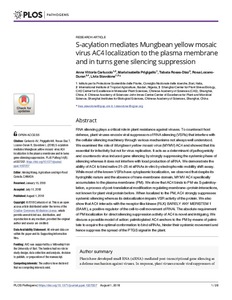| dc.contributor.author | Carluccio, A.V. |
| dc.contributor.author | Prigigallo, M.I. |
| dc.contributor.author | Rosas-Diaz, T. |
| dc.contributor.author | Lozano-Duran, R. |
| dc.contributor.author | Stavolone, L. |
| dc.date.accessioned | 2019-12-04T11:24:29Z |
| dc.date.available | 2019-12-04T11:24:29Z |
| dc.date.issued | 2018-08-01 |
| dc.identifier.citation | Carluccio, A.V., Prigigallo, M.I., Rosas-Diaz, T., Lozano-Duran, R. & Stavolone, L. (2018). S‐acylation mediates Mungbean yellow mosaic virus AC4 localization to the plasma membrane and in turns gene silencing suppression. PLoS pathogens, 14(8):e1007207, 1-26. |
| dc.identifier.issn | 1553-7366 |
| dc.identifier.uri | https://hdl.handle.net/20.500.12478/4382 |
| dc.description | Open Access Journal |
| dc.description.abstract | RNA silencing plays a critical role in plant resistance against viruses. To counteract host defense, plant viruses encode viral suppressors of RNA silencing (VSRs) that interfere with the cellular silencing machinery through various mechanisms not always well understood. We examined the role of Mungbean yellow mosaic virus (MYMV) AC4 and showed that it is essential for infectivity but not for virus replication. It acts as a determinant of pathogenicity and counteracts virus induced gene silencing by strongly suppressing the systemic phase of silencing whereas it does not interfere with local production of siRNA. We demonstrate the ability of AC4 to bind native 21–25 nt siRNAs in vitro by electrophoretic mobility shift assay. While most of the known VSRs have cytoplasmic localization, we observed that despite its hydrophilic nature and the absence of trans-membrane domain, MYMV AC4 specifically accumulates to the plasma membrane (PM). We show that AC4 binds to PM via S-palmitoylation, a process of post-translational modification regulating membrane–protein interactions, not known for plant viral protein before. When localized to the PM, AC4 strongly suppresses systemic silencing whereas its delocalization impairs VSR activity of the protein. We also show that AC4 interacts with the receptor-like kinase (RLK) BARELY ANY MERISTEM 1 (BAM1), a positive regulator of the cell-to-cell movement of RNAi. The absolute requirement of PM localization for direct silencing suppression activity of AC4 is novel and intriguing. We discuss a possible model of action: palmitoylated AC4 anchors to the PM by means of palmitate to acquire the optimal conformation to bind siRNAs, hinder their systemic movement and hence suppress the spread of the PTGS signal in the plant. |
| dc.format.extent | 1-26 |
| dc.language.iso | en |
| dc.subject | Plant Viruses |
| dc.subject | Resistance |
| dc.subject | Mung Beans Yellow Mosaic |
| dc.subject | Rna |
| dc.title | S-acylation mediates Mungbean yellow mosaic virus AC4 localization to the plasma membrane and in turns gene silencing suppression |
| dc.type | Journal Article |
| dc.description.version | Peer Review |
| cg.contributor.crp | Roots, Tubers and Bananas |
| cg.contributor.affiliation | International Institute of Tropical Agriculture |
| cg.contributor.affiliation | Chinese Academy of Sciences |
| cg.creator.identifier | Anna Vittoria Carluccio: 0000-0001-6887-5792 |
| cg.creator.identifier | LIVIA STAVOLONE: 0000-0002-0691-1302 |
| cg.researchtheme | BIOTECH & PLANT BREEDING |
| cg.researchtheme | PLANT PRODUCTION & HEALTH |
| cg.isijournal | ISI Journal |
| cg.authorship.types | CGIAR and developing country institute |
| cg.iitasubject | Plant Breeding |
| cg.iitasubject | Plant Health |
| cg.iitasubject | Plant Production |
| cg.journal | PLoS Pathogens |
| cg.howpublished | Formally Published |
| cg.accessibilitystatus | Open Access |
| local.dspaceid | 100616 |
| cg.targetaudience | Scientists |
| cg.identifier.doi | https://dx.doi.org/10.1371/journal.ppat.1007207 |

